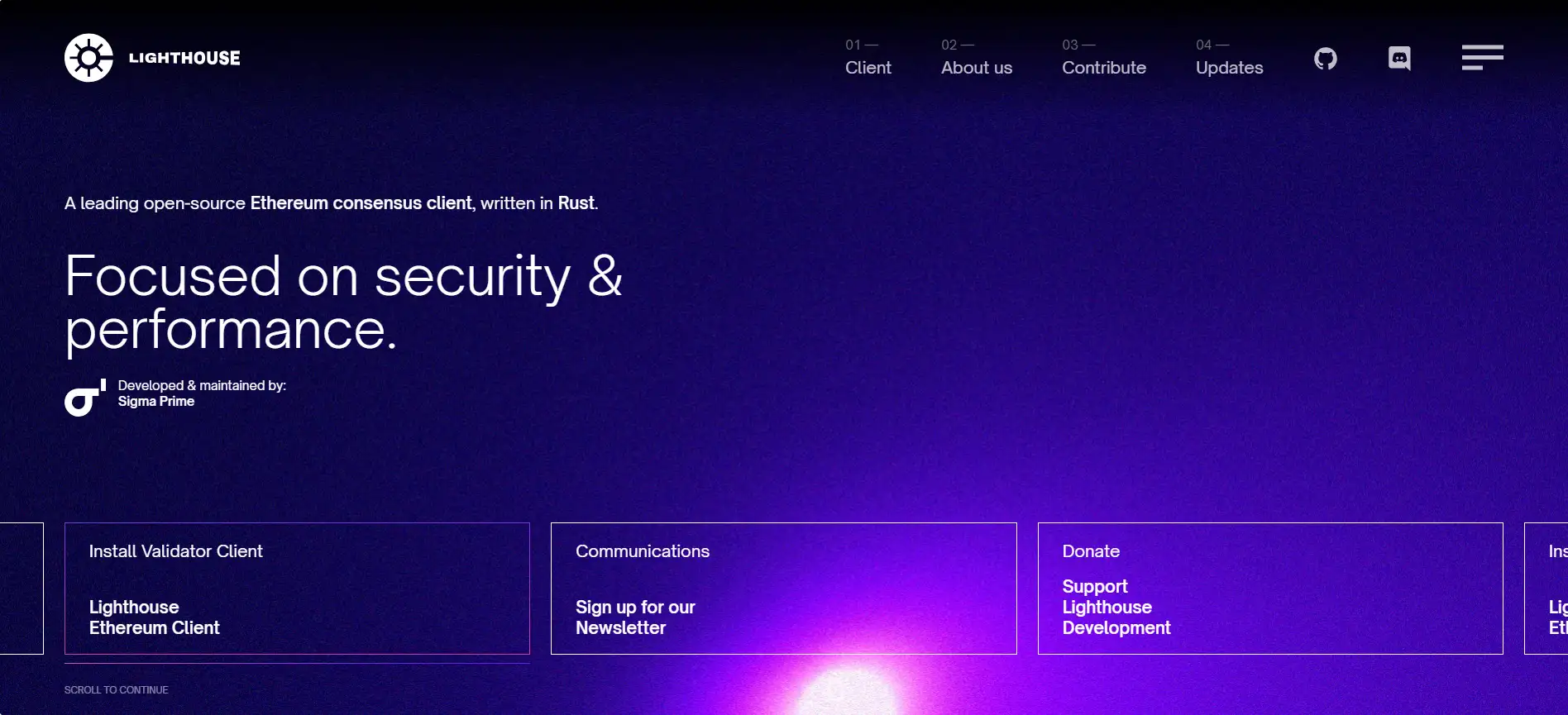About Lighthouse
Lighthouse is a leading open-source Ethereum consensus client developed and maintained by Sigma Prime, an Australian-based blockchain security consultancy. Built in the Rust programming language, Lighthouse is designed with an unwavering focus on security, performance, and sustainability. It plays a crucial role in Ethereum’s Proof-of-Stake (PoS) consensus layer, enabling validators to participate in block proposal and attestation while securing the network. With its security-first architecture and robust engineering practices, Lighthouse has become a trusted choice for Ethereum stakers and infrastructure providers.
The project’s mission is to deliver a stable, efficient, and secure consensus client that contributes to a decentralized and resilient Ethereum ecosystem. Since its inception in 2018, Lighthouse has grown from an experimental side project into a production-grade implementation backed by extensive testing, community contributions, and institutional funding. By providing both a command-line interface and the user-friendly Lighthouse UI (Siren), the project ensures that both advanced developers and new validators can engage with Ethereum staking in a streamlined and transparent way.
Lighthouse originated in early 2018 as part of Ethereum’s transition plan from Proof-of-Work (PoW) to Proof-of-Stake (PoS). Developed by Sigma Prime, the client was intentionally written in Rust due to its performance optimizations, memory safety guarantees, and resilience against common security vulnerabilities. From the start, Lighthouse adopted a “security-first” approach, emphasizing formal verification, fuzz testing, and rigorous code reviews. This approach has led to Lighthouse being one of the most respected and reliable clients in Ethereum’s multi-client ecosystem.
The project reached several significant milestones during Ethereum 2.0’s rollout. It actively participated in early testnets such as Sapphire and Medalla, demonstrating excellent interoperability with other consensus clients like Prysm, Teku, and Nimbus. Lighthouse was fully ready for Ethereum’s mainnet Proof-of-Stake launch in December 2020 and has since been actively maintained with regular updates to adapt to network upgrades such as Altair, Bellatrix, Capella, and Deneb.
One standout feature of Lighthouse is its built-in slasher, a mechanism for detecting and penalizing malicious validator behavior. This not only enhances network security but also offers honest validators the opportunity to receive additional rewards. Alongside its consensus functions, Lighthouse prioritizes user experience by offering the Lighthouse Book—a comprehensive, open-source documentation resource for setup, operations, and troubleshooting. The client also integrates with the Siren UI, giving users a visual and interactive interface to monitor validator performance.
In the competitive consensus client landscape, Lighthouse’s main counterparts include Prysm, Teku, and Nimbus. While these projects also deliver stable PoS consensus clients, Lighthouse stands out for its Rust-based implementation, advanced security tooling, and consistent performance benchmarks across testnets and mainnet.
Lighthouse provides numerous benefits and features that make it a standout choice in the Ethereum consensus client space:
- Security-First Development: Built in Rust with strict memory safety guarantees, reducing attack surfaces and improving overall network reliability.
- High Performance: Optimized for speed and low resource usage, making it ideal for running on both dedicated hardware and cloud infrastructure.
- Integrated Slasher: Detects malicious validators, enforces penalties, and rewards honest participants.
- Open-Source Documentation: The Lighthouse Book offers complete, always-up-to-date installation and operation guides.
- User-Friendly Interface: The Siren UI provides a graphical dashboard to easily monitor and manage Ethereum validators.
- Multi-Client Compatibility: Fully interoperable with other Ethereum consensus clients, supporting the network’s decentralization goals.
- Community & Funding Support: Backed by the Ethereum Foundation, ConsenSys, and individual donors, ensuring long-term sustainability.
To get started with Lighthouse, follow these steps:
- Visit the official Lighthouse website and open the Lighthouse Book section for comprehensive installation instructions.
- Install the Lighthouse Ethereum Client on your preferred operating system using the provided setup commands.
- If you plan to run a validator, ensure you meet the Ethereum staking prerequisites, including the 32 ETH minimum deposit into the Ethereum deposit contract.
- Configure your client according to the documentation, enabling both the beacon node and validator client.
- (Optional) Install the Siren UI for a graphical interface to monitor performance, track rewards, and manage validators.
- Keep your client updated regularly to stay compatible with Ethereum network upgrades.
- Join the Lighthouse Discord server for community support, development news, and troubleshooting assistance.
Lighthouse FAQ
The built-in slasher in Lighthouse is designed to detect and penalize malicious validators who attempt actions such as double-voting or surrounding votes, which can harm the Ethereum Proof-of-Stake network. By running Lighthouse with slashing enabled, you not only help secure the network but can also earn rewards when your client reports dishonest behavior. This function acts as a decentralized enforcement mechanism, reducing the risk of coordinated attacks and improving network integrity.
Rust is a memory-safe, high-performance programming language, and its use in Lighthouse ensures that the client avoids common bugs such as buffer overflows or null pointer dereferencing. This design choice provides strong compile-time guarantees that enhance security while delivering high throughput and low latency. The language’s efficiency allows Lighthouse to run on a wide range of hardware, from cloud servers to small devices, without compromising stability.
You can monitor your validator in Lighthouse by installing the Siren UI, a graphical interface built for validator tracking. This interface lets you see attestation performance, reward history, and real-time system status. For users who prefer command-line tools, Lighthouse also offers detailed logs and metrics endpoints that integrate with monitoring platforms like Prometheus and Grafana.
Lighthouse is part of Ethereum’s multi-client architecture, which ensures network resilience by allowing different software clients—such as Prysm, Teku, and Nimbus—to work together. This approach reduces the risk of a single point of failure if one client experiences a bug. By maintaining strict adherence to Ethereum consensus specifications and participating in cross-client testnets, Lighthouse helps guarantee a robust and decentralized network.
The Lighthouse Book is an open-source, regularly updated guide available on the Lighthouse website. It walks users through installation, validator setup, network participation, and troubleshooting. The resource is designed for both beginners and advanced users, offering examples, best practices, and explanations of Ethereum staking concepts, making it easier for new validators to join the network with confidence.
You Might Also Like












